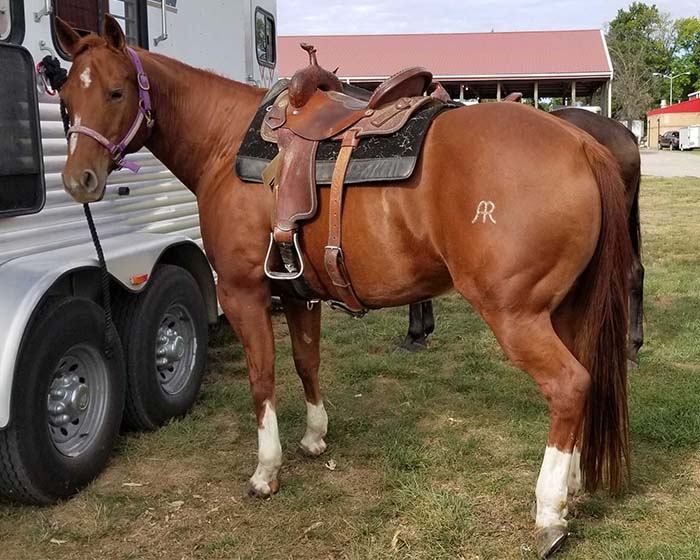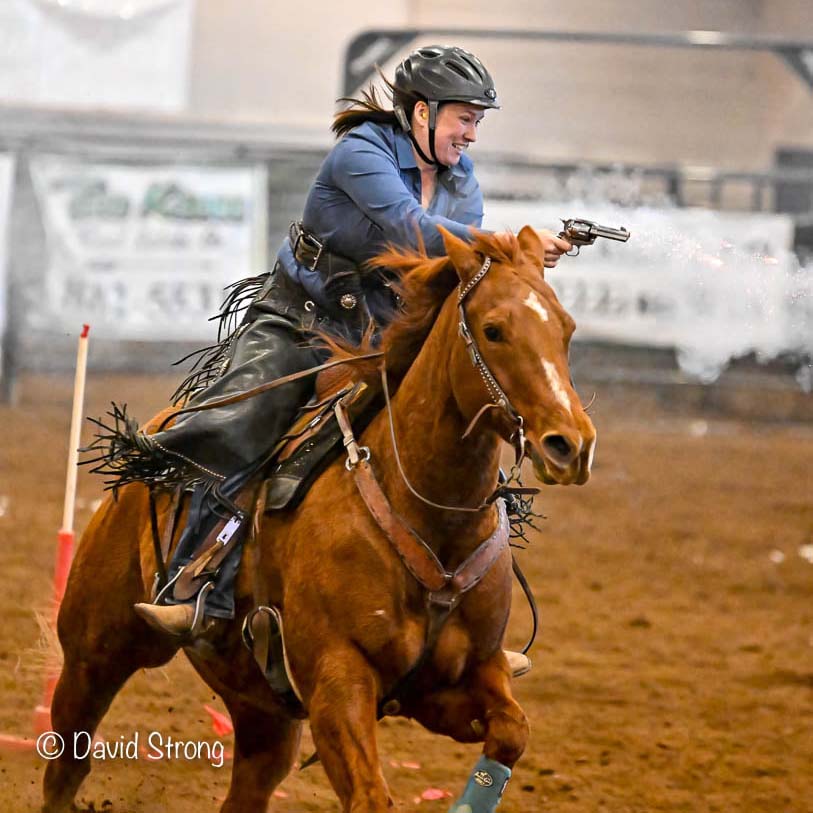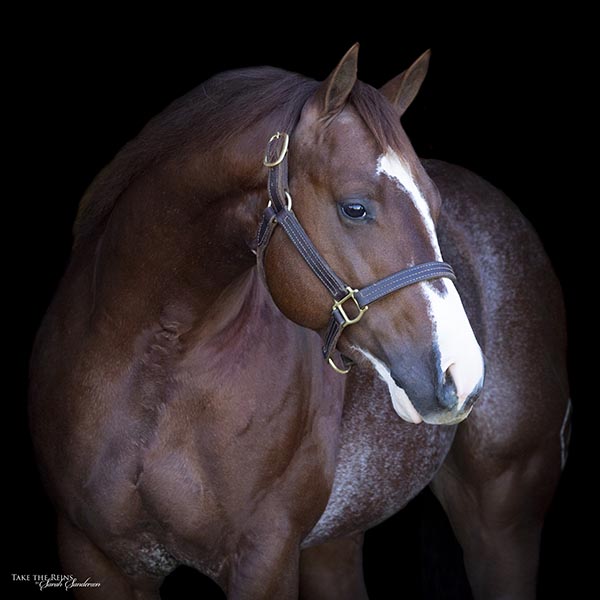
As a horse lover and competitive cowboy mounted shooter, breeding my mare, Sky, has been on my mind for a while now. This year, my mother and I have decided to team up and breed my mare, with the hopes of producing a prospect that is just as talented as Sky. You can learn more about why I chose to breed my mare in the first blog post of this series, Breeding Chronicles Part I: Considerations When Deciding to Breed My Mare.
Once I made the decision to breed my mare, AR Skylines Highbrow (Mr Skyline Peppy x Kats Dainty Gal), also known as Sky, I knew that one of the most important pieces of the process would be choosing and breeding her to the right stallion. As part of a small farm operation and someone who keeps my horses on my parents’ property, it is important to me that this foal will be not only an athlete but also will have an excellent disposition. I plan to ride and compete this foal in the upcoming years, so it would need to be a performance horse. Additionally, while selling the foal is not in my immediate plan, I want to make sure that this foal is saleable in the event that my circumstances change in the future.
When looking at the large number of successful stallions that I could breed to Sky, there were some criteria that I kept in mind. Sky has excellent conformation, so I was looking for a stallion that would complement her ideal shoulder and hip angles. I also hope that the foal will exhibit her big bone and strong hooves. I truly cannot fault Sky’s conformation and find her to be a shining example of the breed. Additionally, she is well-bred (quality bloodlines), having a pedigree with many cutting horse champions in her ancestry. Because of this, I was looking for a stallion that excelled in the cutting pen that could complement her high caliber conformation, especially because I already find her to be such a great representation of the Quarter Horse breed.
When breeding your mare, it is essential to take a hard objective look at her conformation and assess any faults or weaknesses that she may have. In many instances, it is recommended that you ask an outside party that you trust to perform this conformational assessment, since they may be more critical and less biased than you would be. For example, if you have a mare with a longer back, you may want to look for a stud with a shorter back to balance this out. Make sure when you do this conformational analysis that your mare is truly worthy of being bred both physically and temperament wise — they are a large part of the equation and will pass many of their traits (good and bad!) onto the foal, regardless of the quality of the stallion that they are bred to.

It was important to me that this stallion was successful in the show pen because Sky has not competed in cutting (however, both her sire and dam were both very successful on the cutting circuit), this will make the foal more appealing to buyers looking for a quality cutter if I do decide to market the foal. While the foal will be cutting-bred, I expect the foal to be a versatile athlete (just like Sky is!). I believe that a good working cow horse can do almost anything – I know many shooting, reining, barrel, and roping horses, with cutting bloodlines. Although her offspring will be cutting bred and a great prospect, my hopes are that this foal will be athletic enough to go in any performance direction.
After doing some research on my own, I decided to speak with a few experienced friends and equine professionals who are a bit more knowledgeable about her bloodlines than I am and routinely make breeding-based decisions. Many of them suggested that because Sky is Highbrow Cat bred, she may produce high-quality offspring when bred to a stallion with Dual Rey in his pedigree. This is because, historically, these bloodlines improve upon one another and have resulted in foals that were of greater quality and athletic ability than both the sire and dam. This helped to narrow down my search and allow me to focus on some prominent stallions in the cutting industry. Additionally, the American Quarter Horse Association (AQHA) has a useful stallion direction that allows you to view stallions that complement your mare’s bloodlines, by looking at past progeny. Many Quarter Horse enthusiasts find QStallions to be a very helpful resource.
Eventually, after much consideration, studying various photos, and watching numerous videos, we settled on the 2014 sorrel stallion, Dual Reyish (Hottish x A Little Reylena by Dual Rey), owned by Wolf Livestock. Not only is he a popular stallion at the moment due to the quality of his past foal crops, but he has also earned over $456,016 in cutting competitions and was also recently inducted into the National Cutting Horse Association (NCHA) Hall of Fame due to his athletic prowess and abilities in the cutting pen. He has had a very successful career in the show pen, winning honors including 2017 NCHA Open Futurity Champion, 2018 Breeders Invitational Open Derby Champion, and 2020 Augusta Futurity Open Classic Champion. Additionally, his foals are eligible for a number of prize money incentive programs, such as the Breeders Invitational, NCHA Super Stakes, Bonanza Cutting, PCCHA, National Reining Breeders Classic, and NRCHA Stallion Stakes. You can check him out in action in the video below:
When looking at Dual Reyish’s conformation photos, I was impressed by his balanced body and his sloping shoulder angle. His nice square hip is set in such a way that he is able to sit down on his hocks when working a cow, a very important trait for a quality cutting horse. Additionally, he has a compact topline, this allows him to turn quickly and adjust for the cow’s movements when working cattle. When looking at the front and back views, he has straight legs (he is not cow hocked as some Quarter Horses can be), which will hopefully help to keep him sound for many years to come. These are all traits that I would like to see exhibited by my foal. You can learn more about ideal Quarter Horse conformation in this AQHA article, Balanced Horse Conformation. Sky is on the taller end of the spectrum, so I hope that she will add so height to the baby. I believe that breeding Sky to Dual Reyish will produce a high-quality foal with excellent conformation and athleticism.

In addition to his optimal conformation, cow sense, and the trainable demeanor that we hope he passes on to his offspring, I was drawn to the fact that he is double registered with the American Quarter Horse Association (AQHA) and the American Paint Horse Association (APHA). This means that the foal will also be eligible to be double registered with AQHA and APHA, either as a Solid-Paint Bred (formerly referred to as Breeding Stock) or as a Regular Paint.
If Dual Reyish passes along enough color to the foal, the baby will be eligible for Regular APHA Registration. For this to happen, a foal has to meet two requirements. First, they must be the progeny of at least one horse with Paint Horse parentage — the other parent can either be registered with APHA, AQHA, or the Jockey Club (JC). Then, the foal must exhibit a minimum amount of coloration to make them a Paint. According to the APHA, “In addition to the bloodline requirement, all American Paint Horses in the Regular Registry meet a minimum color requirement. Paint Horses that are predominantly colored must have a definite ‘natural’ Paint marking. A ‘natural’ Paint marking is an area of solid white hair with some underlying, unpigmented skin. When the horse has a predominantly white hair coat, it must have a contrasting area of color with some underlying, pigmented skin… To be eligible for the Regular Registry, the foal must have at least one ‘natural’ Paint marking that is more than 2 inches in diameter. The contrasting spot need not be visible when the horse is standing.”

As a Paint Horse stallion, there are a number of genetic tests that Dual Reyish had to undergo before standing at stud. He is 6-Panel N/N, which means that he tested negative for the numerous genetic markers they look for which could be potentially detrimental to the foal’s quality of life. This means that he is not a carrier of hyperkalemic periodic paralysis (HYPP), hereditary equine regional dermal asthenia (HERDA), glycogen branching enzyme deficiency (GBED), malignant hyperthermia (MH), polysaccharide storage myopathy (PSSM), or Overo lethal white syndrome (OLWS). Because Sky has also tested negative for these genetic disorders, we can be confident that the foal will not have them either.
I have owned Paint horses in the past, so I am hopeful that Sky’s baby with Dual Reyish will exhibit enough white to be eligible for regular Paint horse registration. However, I know that even if she has a solid-colored baby, it will still be a high-quality foal that I am excited to develop into a performance horse. I have so many hopes and dreams for this foal!
Now that we have selected a stallion, the next step is to breed Sky and hopefully get her in foal. I am fortunate enough to have an experienced veterinarian live across the street from me, and he will guide us through the process. Currently, Sky is under lights during the early morning and evening hours to transition her into her heat cycles for the year, and we hope to get her body cycling normally. Once this has happened, we will begin the preparations for the breeding process. I hope that you will keep reading this blog series when I report back with information about the actions we need to take to get Sky pregnant through artificial insemination (AI). This has been a dream of mine for many years, and I am so excited to have you follow along with me on this journey.
